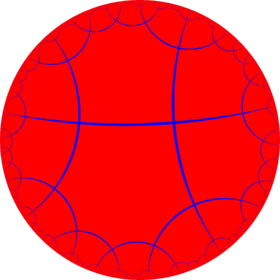
Summary
| Order-4 heptagonal tiling | |
|---|---|
 Poincaré disk model of the hyperbolic plane | |
| Type | Hyperbolic regular tiling |
| Vertex configuration | 74 |
| Schläfli symbol | {7,4} r{7,7} |
| Wythoff symbol | 4 | 7 2 2 | 7 7 |
| Coxeter diagram | |
| Symmetry group | [7,4], (*742) [7,7], (*772) |
| Dual | Order-7 square tiling |
| Properties | Vertex-transitive, edge-transitive, face-transitive |
In geometry, the order-4 heptagonal tiling is a regular tiling of the hyperbolic plane. It has Schläfli symbol of {7,4}.
Symmetry edit
This tiling represents a hyperbolic kaleidoscope of 7 mirrors meeting as edges of a regular heptagon. This symmetry by orbifold notation is called *2222222 with 7 order-2 mirror intersections. In Coxeter notation can be represented as [1+,7,1+,4], removing two of three mirrors (passing through the heptagon center) in the [7,4] symmetry.
The kaleidoscopic domains can be seen as bicolored heptagons, representing mirror images of the fundamental domain. This coloring represents the uniform tiling t1{7,7} and as a quasiregular tiling is called a heptaheptagonal tiling.
Related polyhedra and tiling edit
| Uniform heptagonal/square tilings | |||||||||||
|---|---|---|---|---|---|---|---|---|---|---|---|
| Symmetry: [7,4], (*742) | [7,4]+, (742) | [7+,4], (7*2) | [7,4,1+], (*772) | ||||||||
| {7,4} | t{7,4} | r{7,4} | 2t{7,4}=t{4,7} | 2r{7,4}={4,7} | rr{7,4} | tr{7,4} | sr{7,4} | s{7,4} | h{4,7} | ||
| Uniform duals | |||||||||||
| V74 | V4.14.14 | V4.7.4.7 | V7.8.8 | V47 | V4.4.7.4 | V4.8.14 | V3.3.4.3.7 | V3.3.7.3.7 | V77 | ||
| Uniform heptaheptagonal tilings | |||||||||||
|---|---|---|---|---|---|---|---|---|---|---|---|
| Symmetry: [7,7], (*772) | [7,7]+, (772) | ||||||||||
| = = |
= = |
= = |
= = |
= = |
= = |
= = |
= = | ||||
| {7,7} | t{7,7} |
r{7,7} | 2t{7,7}=t{7,7} | 2r{7,7}={7,7} | rr{7,7} | tr{7,7} | sr{7,7} | ||||
| Uniform duals | |||||||||||
| V77 | V7.14.14 | V7.7.7.7 | V7.14.14 | V77 | V4.7.4.7 | V4.14.14 | V3.3.7.3.7 | ||||
This tiling is topologically related as a part of sequence of regular tilings with heptagonal faces, starting with the heptagonal tiling, with Schläfli symbol {6,n}, and Coxeter diagram , progressing to infinity.
| {7,3} |
{7,4} |
{7,5} |
{7,6} |
{7,7} |
This tiling is also topologically related as a part of sequence of regular polyhedra and tilings with four faces per vertex, starting with the octahedron, with Schläfli symbol {n,4}, and Coxeter diagram , with n progressing to infinity.
| *n42 symmetry mutation of regular tilings: {n,4} | |||||||
|---|---|---|---|---|---|---|---|
| Spherical | Euclidean | Hyperbolic tilings | |||||
| 24 | 34 | 44 | 54 | 64 | 74 | 84 | ...∞4 |
References edit
- John H. Conway, Heidi Burgiel, Chaim Goodman-Strauss, The Symmetries of Things 2008, ISBN 978-1-56881-220-5 (Chapter 19, The Hyperbolic Archimedean Tessellations)
- "Chapter 10: Regular honeycombs in hyperbolic space". The Beauty of Geometry: Twelve Essays. Dover Publications. 1999. ISBN 0-486-40919-8. LCCN 99035678.
See also edit
External links edit
- Weisstein, Eric W. "Hyperbolic tiling". MathWorld.
- Weisstein, Eric W. "Poincaré hyperbolic disk". MathWorld.
- Hyperbolic and Spherical Tiling Gallery
- KaleidoTile 3: Educational software to create spherical, planar and hyperbolic tilings
- Hyperbolic Planar Tessellations, Don Hatch


